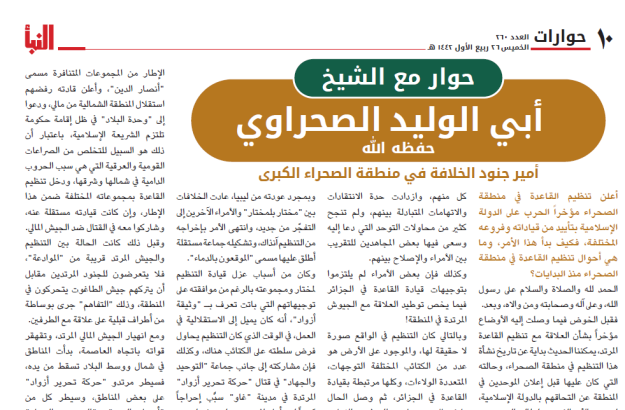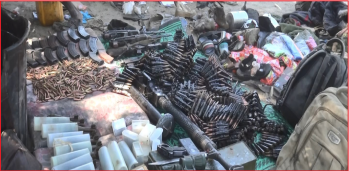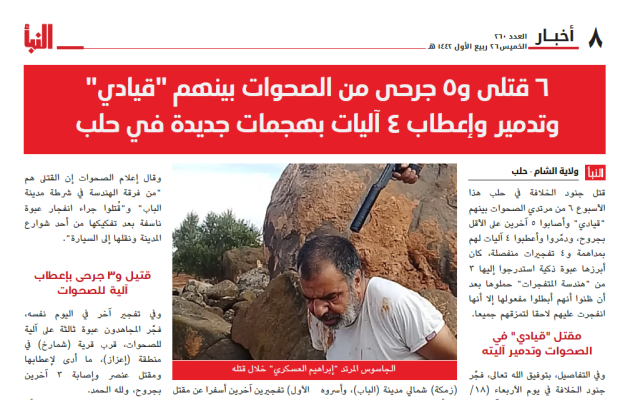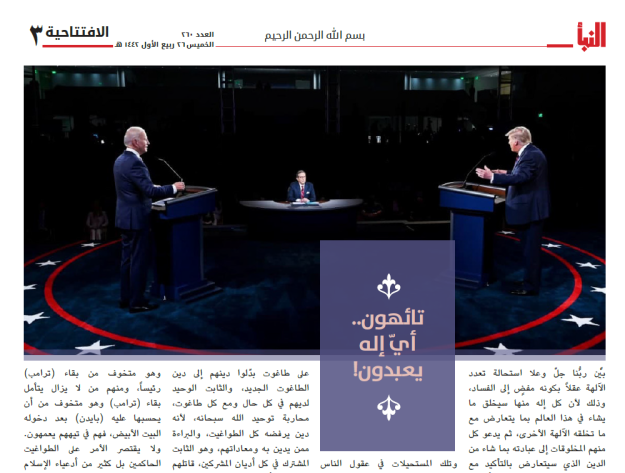By Kyle Orton (@KyleWOrton) on 15 November 2020

Al-Naba 260, page 10
The Islamic State (IS) put out the 260th edition of its newsletter, Al-Naba, on 13 November. Much of the focus was on IS’s war with its jihadi rival, Al-Qaeda, in northern and western Africa. There are reports of guerrilla operations from elsewhere in Africa, from the Centre (in Iraq and Syria), as well as from Egypt and Afghanistan. IS notably feels secure enough in the strength of its networks to draw attention to its responsibility for several attacks in the Turkish-held areas of northern Syria, and there is a rare report of an attack in Indonesia. Al-Naba 260 also has IS’s response to the U.S. Election.
Probably the most interesting part of Al-Naba 260 is contained at the end, on pages ten and eleven, where Lehbib Yumani (Adnan Abu Walid al-Sahrawi), described as “the emir of the caliphate’s soldiers in the Greater Sahara zone (mantaqat al-sahara al-kubra)”. Yumani leads what was once known as the “Islamic State in the Greater Sahara” (ISGS), a jihadi outfit that has been subsumed within the Islamic State’s West Africa Province (ISWAP). Yumani focuses almost entirely on criticising Al-Qaeda as ideologically and organisationally deficient, in contrast to IS’s presence in the area, which is unified and coherent in its pursuit of jihadist goals.
Asked about Al-Qaeda’s declaration of war on the Islamic State (IS) in West Africa, Yumani says that to understand how the present situation arose, one has to look at how it began and then gives a potted history of the history of jihadism in the region, pointing to its roots in Algeria, specifically the war there in the 1990s, but notably beginning with the Salafist Group for Preaching and Combat (GSPC), which emerged in 1998, and not mentioning the Armed Islamic Group (GIA).
Yumani says a number of “pioneers” (rawad) arrived in north-west Niger and Mali to create a supply line and safe area of the jihad that was then-ongoing in Algeria. Despite initial successes, “the work suffered major setbacks due to differences and disputes between the various emirs and brigades, which has become a general feature that has characterized the situation over the past years”, and this did not end when GSPC joined Al-Qaeda and became Al-Qaeda in the Islamic Maghreb (AQIM) in 2007.
AQIM was an “unreal image”, says Yumani, comprising “on the ground a number of brigades with different orientations and multiple allegiances”. Yumani blames the continued dysfunction of AQIM on the fact that all of its nominal units were tied to the Algerian leadership, making communications slow. Divisions increased in intensity, Yumani says, and all unity efforts failed.
Another problem, says Yumani, was that “some of the emirs would not adhere to the directives from Al-Qaeda’s leadership in Algeria concerning the establishment of relations with the apostate armies in the region!” It is unclear whether this passing reference is to limited things like Al-Qaeda’s proposal for a deal with Mauritania, or the more general issue of infiltration of jihadist groups in West Africa by state intelligence services, particularly Algeria’s secret police, the Department of Intelligence and Security (DRS). In Al-Naba 239 in June, IS accused Al-Qaeda in the Arabian Peninsula (AQAP) of waging war against it because it was controlled by Western spies; if the intent was to make the same argument about AQIM, Yumani did not flesh it out.
There was an effort to appoint a unified commander, Yumani goes on, “Nabil Abu al-Qama”, a reference to Nabil Makhloufi, but it came to naught. The appointment was easy, says Yumani, but it never took hold on the ground. Yumani singles out Mokhtar Belmokhtar and Katibat Tareq bin Zayad as being particularly responsible for frustrating unity efforts. Yumani says some degree of unity was established by the end of 2011, by which time the war in Libya had begun, and fragmentation set in again as some groups got involved there. Official splits followed with the formation of the Movement for Monotheism and Jihad in West Africa (best known by the acronym MUJAO) and Belmokhtar’s “Al-Muqa’oon Baldama” (الموقعون بالدماء) or “Signatories With Blood” Brigade.
With the collapse of Muammar al-Qaddafi’s regime “under [pressure from] the Crusader airstrikes and the opposition forces, many factions loyal to him returned to Mali,” loaded with weapons and money that had either been given to them by Col. Qaddafi or that they had seized from the Libyan Army in the south after authority collapsed in the country, says Yumani, and this allowed them to begin a rebellion against the Malian government, intended to create an independent state in northern Mali, under the framework of the “apostate” Azawad National Liberation Movement (MNLA).
There were ethnic schisms within the Malian insurgency, and there were religious ones, notably Ansar Dine (more properly, Ansar al-Deen), which broke away from MNLA and declared for a shari’a state. The Malian army retreated to the capital of Bamako, says Yumani, allowing MNLA to take control of some areas, while Ansar Dine and MUJAO took control of others. Yumani says Al-Qaeda tried to have Ansar Dine and MNLA come to terms on power-sharing in the area of northern Mali the insurgents had grabbed, but MNLA refused and fighting broke out, which ended with MNLA pushed back to the area near the Algerian border.
The “apostates” could have been destroyed at this stage, says Yumani, but instead Al-Qaeda released its “Azwad Document” (Watheeqa Azwad), which prevented the jihadists operating in those areas near the Algerian border and instead tried to win over MNLA by various means, all of which failed, and after the “French-led Crusade” began in January 2013 the “secularists and nationalists” among the insurgents joined with the French to expel the jihadists. It was only at this point Ansar Dine realised its mistake, says Yumani, discovering that “all their flattery of [MNLA] did not prevent them from turning into Awakening [forces] fighting on the side of the Crusaders”.
The Azwadi nationalists joined the “French Crusade”, says Yumani, hoping to realise their old ambition of a separate state, and under the strain of defeat Ansar Dine cracked, with some of its leaders and subunits joining the French and nationalist rebels. Al-Qaeda tried to retain is hidden-hand approach and outreach to the localist forces throughout all this, says Yumani. MUJAO and Belmokhtar’s group merged into Al-Murabitun in August 2013 under the leadership of Ahmad al-Amer, but he was killed in January 2015 (Rabi al-Thani/Rabiʽ al-Akhir 1436).
Four months later, in May 2015, IS entered the West African theatre when Yumani gave his bay’a (oath of allegiance) to the caliph, Ibrahim al-Badri (Abu Bakr al-Baghdadi), an oath of course renewed to the new IS leader, Abu Ibrahim al-Hashemi al-Qurayshi.
Yumani says there was much rejoicing among jihadists at the restoration of the caliphate, with a belief this would end the strife among them. But Al-Qaeda was not pleased by the return of the caliphate, says Yumani, and goes on to argue that the origin of the intra-jihadi clashes in the Sahel is the trend of defections from Al-Qaeda groups to IS.
Al-Qaeda continued to show greater loyalty to “nationalist” factions with which they had built relations as a foundation for their emirates, says Yumani, the implication being that this was an indirect effort to form a common front to strangle IS in its cradle in West Africa. Al-Qaeda even banned its supporters from reading IS media, Yumani complains, though his advocacy of free expression does not seem to be general. Al-Qaeda escalated to arresting and killing people who tried to leave their groups to join IS.
“In order to stand against the Islamic State,” says Yumani, “the sections of Al-Qaeda, and its allies, decided eventually [in March 2017] to unite into one faction, which they called “Jamaat Nasr al-Islam wal-Muslimeen [JNIM]”. In so doing, what united them was their hostility to al-muwahideen (the monotheists)!”
Yumani went on: “At the same time, [Al-Qaeda] spared no effort in spreading false news about the Islamic State among the general public [or ‘common people’ (a’mat al-nas)] in order to alienate them from the caliphate’s soldiers … [A]fter every battle between the muwahideen and the apostate factions, the apostates of Al-Qaeda would go to the tribes to incite them to fight the mujahideen in revenge for the apostates.”
Yumani lays out in some detail the various theatres in which intra-jihadi fighting took place, spreading from Mali and Niger into Burkina Faso and Mauritania. Naturally, Yumani says the root cause was Al-Qaeda’s betray of God and the True Religion. More interesting was Yumani’s confirmation that IS in West Africa did seek to avoid fighting with Al-Qaeda for quite some time, a situation of non-aggression or deconfliction that led to bizarre reports of collaboration until open hostilities erupted in the spring and war was declared in May 2020.
“The soldiers of the Islamic State … worked to call people to goodness, explain the facts of the situation to them … and respond to the lies that are told about them, and this continued for several years”, Yumani told Al-Naba. “They (IS) avoided clashing with Al-Qaeda and its allies as much as possible, while they continued to fight the Crusaders and the apostates”.
According to Yumani’s account, Al-Qaeda initiated the war against the Islamic State in north and west Africa because it was hemorrhaging members to IS, after being unable to persuade its own loyalists ideologically to stick with Al-Qaeda. After a lengthy description of the course of the politico-military dispute, Yumani concludes that Al-Qaeda in the Maghreb area is, through its “delusion and arrogance”, following “in the footsteps of the apostate ‘Taliban’ movement in fighting the muwahideen”, while chasing after negotiations with the West in the hopes of securing their interests through the disbelievers’ approval.
* * * * *
Very much related to the Yumani interview, on the page before, page nine, is a gloating report via a “special source” or “private source” (masdar khasun), accompanied by a grim picture, from the “West Africa Province” about the “dozens” of men killed and wounded in “the latest operations of the mujahideen against the apostates of ‘Al-Qaeda’ in the Sahel region”.
The ISWAP attacks on Al-Qaeda began in Muharram 1442 [mid-August to mid-September 2020], according to Al-Naba 260; there have been a total of twenty-six attacks over the last three months. The ISWAP attacks on JNIM/Al-Qaeda have taken place mostly in Mali and Burkina Faso, by this account, and killed nearly eighty Al-Qaeda jihadists.
The south-eastern Est Region of Burkina Faso seems to be where the reports concentrate, though there are some from further north, such as in Djibo. Al-Naba 260 lists a series of assassinations by IS, generally of two of three Al-Qaeda operatives in villages and small towns, including two in the middle of a market; raids on Al-Qaeda encampments in forests; and a major ambush in the N’Tillit area of Mali near Gao (in the tri-border area with Burkina Faso and Niger) that allegedly killed thirty Al-Qaeda jihadists.
* * * * *
Africa is also the focus of page seven, with a major report from Nigeria and a smaller one from the Congo.

Al-Naba 260, page 7
The Nigeria report in Al-Naba 260, designated as “West African Province”, claims the killing and wounding of twenty Nigerian soldiers and the destruction of eight military vehicles. The article is accompanied by a picture of ghanima (war spoils) seized from the Nigerian Army in the town of Karito in the Borno region (see left). IS claims these casualties were inflicted in five separate operations, including attacks on barracks, ambushes of moving vehicles, and mortar shelling of military encampments. The Nigeria section finishes with “last week” section on the killing and wounding of sixty Nigerian soldiers and the burning of a Christian village that killed twelve people, something of which IS is clearly very proud.
The report from the Democratic Republic of the Congo, labelled as “Central African Province” (ISCAP), says that “the soldiers of the caliphate, on Sunday, 22 Rabi al-Awwal [8 November], attacked a gathering of soldiers from the Crusader Congolese Army in the village of Kisima in the region of Beni. Clashes took place with weapons of varying kinds, which led to the killing of three soldiers, while the rest of them fled, and the mujahideen seized a variety of weapons and ammunition before returning to their bases safely”. The Congo section also ends by reliving an anti-Christian attack from last week, and the raid into Tanzania from Mozambique, the other ISCAP area of operations in Sub-Saharan Africa.
* * * * *

Front page of Al-Naba 260
The main story on the front page of Al-Naba 260 is the killing of eighteen Iraqi security forces, Shi’i militiamen, and tribal fighters, the wounding of eighteen more, and the destruction of eight vehicles, “carried out by the caliphate’s soldiers in the ‘Baghdad belt’ (hizam Baghdad), specifically in the areas of Al-Radwaniya and Jurf al-Sakhar, south of Baghdad”. There were senior officers among the casualties, says Al-Naba, which calls these attacks “a remarkable military escalation and a massive security breach” for the Iraqi security forces (ISF), about which they have been holding high-level meetings to assess the damage.
In their extended unpacking of these events, which continues on page four, IS names one of the people it murdered, Mustafa Qaduri al-Shammari, a policemen, assassinated with machine gun fire on 6 November in the Shajeeriya area north of Al-Kut, a town about 100 miles south-east of Baghdad. The Radwaniya attack was two days after that, according to Al-Naba, an IS assault on the barracks of a “Tribal Hashd” detachment that killed eighteen and destroyed/damaged six of the vehicles. This was within range of Baghdad International Airport, says Al-Naba, marking a serious breakthrough for the jihadist insurgents. And six ISF were then killed and wounded in Jurf, and two vehicles damaged, by an IED, and IS guerrillas then attacked the survivors and a second ISF vehicle that came to assist, killing and wounding ten more people.
Page five lauds IS for killing one member of the Iraqi security forces and damaging or destroying three vehicles in Diyala, plus killing seven men (from the police, army, and Hashd al-Shabi) in Salahuddin province, while damaging or destroying five vehicles, three of them bulldozers. A barracks in Salahuddin was also targeted. There is then an item from Afghanistan: “on Thursday, 19 Rabi al-Awwal [5 November], the soldiers of the caliphate detonated an explosive device against two members of the apostate Afghan police, in District 9 of the city of Jalalabad, which led to them being injured”. Al-Naba then summarises last week’s report on the IS-Khorasan (ISK) massacre at Kabul University and reiterates IS’s satisfaction at the atrocity.
Page six continues the reports of guerrilla operations: three in Iraq—two in Kirkuk that killed twelve security forces and a roadside bomb in Ninawa that wounded two—plus an attack in Egypt’s Sinai and, most interestingly because it is the most rare, an attack in Indonesia. Reported from the “East Asia Province”, from a “private source”, the notice reads: “on Thursday, 5 Rabi Al-Awwal [Oct. 22], the soldiers of the caliphate targeted a member of the Indonesian apostate police, in the Central Sulawesi region, shooting him with a pistol and killing him instantly”.
Page eight is two guerrilla reports from Syria. The second report, from Al-Khayr (Deir Ezzor), notes a 4 November ambush of an Asad regime vehicle west of Al-Mayadeen and 10 November attack with an IED on a PKK vehicle in Hajin, killing and wounding three. These attacks in the eastern deserts of Syria are quite “normal” by this stage.
More interesting is the first report on page eight, claiming an uptick in IS operations in the areas of Aleppo province controlled by Turkey, a trend that has been noted by the Turkish proxy groups themselves. IS claims to have been responsible for the roadside bombing that killed a leader of Faylaq al-Sham, Hamdo Hammadi, and two others, near Al-Bab, on 4 November. The next day, says Al-Naba, IS assassinated Ibrahim al-Askari, “an apostate spy from Firqat al-Hamza”, in his own home, using a silenced pistol, in the village of Zamka, north of Al-Bab. A picture of Al-Askari accompanies the article (see below). Next, says Al-Naba, there were two bombing attacks against “the apostate Awakening” (al-sahwat al-murtadeen) on 7 November around Al-Bab, a bombing the same day in Azaz against a car belonging to Liwa al-Sultan Murad, and finally, on 9 November, a roadside bombing against “the Sahwa” on a road near Jarabulus.

Al-Naba 260, page 8: Ibrahim al-Askari, a “spy” for the Syrian “Awakening” killed by Islamic State north of Al-Bab
* * * * *
The main editorial on page three relates to the American Election. IS condemns those who concern themselves with the replacement of one impious ruler by another, especially through a mechanism as blasphemous as democracy, saying that each American President is worse than “the Rafida (Shi’a) awaiting their alleged Mahdi!” IS has some fun at the expense of the regional governments who hedged their early reactions after President Donald Trump refused to concede his defeat. While some Arab governments (IS does not mention names but Saudi Arabia and the United Arab Emirates must be in their mind) worried that Joe Biden would hold it against them once he is in the White House that they were pro-Trump during this moment, says Al-Naba, they also had to worry what would happen if Trump doesn’t leave and they have congratulated Biden.

Al-Naba 260, page 3